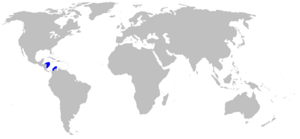Narrowtail catshark facts for kids
Quick facts for kids Narrowtail catshark |
|
|---|---|
| Conservation status | |
| Scientific classification | |
| Genus: |
Schroederichthys
|
| Species: |
maculatus
|
 |
|
The narrowtail catshark (Schroederichthys maculatus) is a type of catshark. It belongs to the Scyliorhinidae family. You can find this shark in the waters near Honduras and Nicaragua. It lives deep in the ocean, usually between 190 and 410 meters (about 623 to 1,345 feet) down. This shark is quite small, growing up to 35 centimeters (about 14 inches) long. It lays eggs to reproduce.
What Does It Look Like?
The narrowtail catshark has a long, slender body. It looks like this when it's young and when it's fully grown. Its back and sides are light grey or tan. You can see white spots all over its body.
Young narrowtail catsharks have special markings. They have six to nine light brown, saddle-shaped stripes on their backs. As they get older, these stripes slowly disappear. The shark's belly is a pale color.
Where Does It Live?
The narrowtail catshark lives only in the Caribbean Sea. This means it is endemic to that area. You can find it off the coasts of Honduras, Nicaragua, and Colombia. It also lives in the sea between Honduras and Jamaica.
This shark prefers to live on the edge of the continental shelf. It also likes the upper parts of the ocean slope. It usually stays between 190 and 410 meters (about 623 to 1,345 feet) deep. It likes to be above seabeds made of fine, chalky materials.
How Does It Live?
The narrowtail catshark is a demersal species. This means it lives and feeds near the bottom of the ocean. It swims close to the seabed. It mostly eats small fish and cephalopods, like squid or octopuses. Scientists once found algae in the stomach of one of these sharks.
Reproduction
This catshark is oviparous. This means the female shark lays eggs. She probably lays one egg at a time from each of her oviducts. The baby shark inside the egg gets all its food from the egg yolk.
Scientists have noticed something interesting about this shark. Unlike other sharks in its group, the narrowtail catshark keeps its body shape as it grows. It stays small and looks like a young shark even when it's an adult.
Is It Safe?
We don't know much about the narrowtail catshark. We also don't know a lot about how it lives. It only lives in a small area of the ocean. However, it is not often caught by fishing boats. This is because there are no big fishing operations in the Caribbean Sea at the depths where this shark lives.
Because there are no known threats to this shark, its population seems to be stable. The International Union for Conservation of Nature (IUCN) has looked at its situation. They have decided that its conservation status is "least concern". This means it is not currently in danger.


